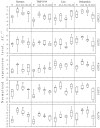Glutathione S-transferases and UDP-glycosyltransferases Are Involved in Response to Aluminum Stress in Flax
- PMID: 28066475
- PMCID: PMC5174120
- DOI: 10.3389/fpls.2016.01920
Glutathione S-transferases and UDP-glycosyltransferases Are Involved in Response to Aluminum Stress in Flax
Abstract
About 30% of the world's ice-free land area is occupied by acid soils. In soils with pH below 5, aluminum (Al) releases to the soil solution, and becomes highly toxic for plants. Therefore, breeding of varieties that are resistant to Al is needed. Flax (Linum usitatissimum L.) is grown worldwide for fiber and seed production. Al toxicity in acid soils is a serious problem for flax cultivation. However, very little is known about mechanisms of flax resistance to Al and the genetics of this resistance. In the present work, we sequenced 16 transcriptomes of flax cultivars resistant (Hermes and TMP1919) and sensitive (Lira and Orshanskiy) to Al, which were exposed to control conditions and aluminum treatment for 4, 12, and 24 h. In total, 44.9-63.3 million paired-end 100-nucleotide reads were generated for each sequencing library. Based on the obtained high-throughput sequencing data, genes with differential expression under aluminum exposure were revealed in flax. The majority of the top 50 up-regulated genes were involved in transmembrane transport and transporter activity in both the Al-resistant and Al-sensitive cultivars. However, genes encoding proteins with glutathione transferase and UDP-glycosyltransferase activity were in the top 50 up-regulated genes only in the flax cultivars resistant to aluminum. For qPCR analysis in extended sampling, two UDP-glycosyltransferases (UGTs), and three glutathione S-transferases (GSTs) were selected. The general trend of alterations in the expression of the examined genes was the up-regulation under Al stress, especially after 4 h of Al exposure. Moreover, in the flax cultivars resistant to aluminum, the increase in expression was more pronounced than that in the sensitive cultivars. We speculate that the defense against the Al toxicity via GST antioxidant activity is the probable mechanism of the response of flax plants to aluminum stress. We also suggest that UGTs could be involved in cell wall modification and protection from reactive oxygen species (ROS) in response to Al stress in L. usitatissimum. Thus, GSTs and UGTs, probably, play an important role in the response of flax to Al via detoxification of ROS and cell wall modification.
Keywords: Linum usitatissimum; UDP-glycosyltransferase; acid soil; aluminum stress; flax; gene expression; glutathione S-transferase; transcriptome sequencing.
Figures

Similar articles
-
Aluminum Responsive Genes in Flax (Linum usitatissimum L.).Biomed Res Int. 2019 Feb 28;2019:5023125. doi: 10.1155/2019/5023125. eCollection 2019. Biomed Res Int. 2019. PMID: 30941364 Free PMC article.
-
miR319, miR390, and miR393 Are Involved in Aluminum Response in Flax (Linum usitatissimum L.).Biomed Res Int. 2017;2017:4975146. doi: 10.1155/2017/4975146. Epub 2017 Feb 19. Biomed Res Int. 2017. PMID: 28299328 Free PMC article.
-
[CAX3 Gene is Involved in Flax Response to High Soil Acidity and Aluminum Exposure].Mol Biol (Mosk). 2018 Jul-Aug;52(4):595-600. doi: 10.1134/S0026898418040195. Mol Biol (Mosk). 2018. PMID: 30113025 Russian.
-
Aluminum toxicity and aluminum stress-induced physiological tolerance responses in higher plants.Crit Rev Biotechnol. 2021 Aug;41(5):715-730. doi: 10.1080/07388551.2021.1874282. Epub 2021 Apr 18. Crit Rev Biotechnol. 2021. PMID: 33866893 Review.
-
Flax (Linum usitatissimum L.): A Potential Candidate for Phytoremediation? Biological and Economical Points of View.Plants (Basel). 2020 Apr 13;9(4):496. doi: 10.3390/plants9040496. Plants (Basel). 2020. PMID: 32294947 Free PMC article. Review.
Cited by
-
Evolution of blue-flowered species of genus Linum based on high-throughput sequencing of ribosomal RNA genes.BMC Evol Biol. 2017 Dec 28;17(Suppl 2):253. doi: 10.1186/s12862-017-1105-x. BMC Evol Biol. 2017. PMID: 29297314 Free PMC article.
-
Identification of Glutathione S-Transferase Genes in Hami Melon (Cucumis melo var. saccharinus) and Their Expression Analysis Under Cold Stress.Front Plant Sci. 2021 Jun 8;12:672017. doi: 10.3389/fpls.2021.672017. eCollection 2021. Front Plant Sci. 2021. PMID: 34168669 Free PMC article.
-
Transcriptomes of Different Tissues of Flax (Linum usitatissimum L.) Cultivars With Diverse Characteristics.Front Genet. 2020 Nov 30;11:565146. doi: 10.3389/fgene.2020.565146. eCollection 2020. Front Genet. 2020. PMID: 33363567 Free PMC article. No abstract available.
-
Flax (Linum usitatissimum L.) response to non-optimal soil acidity and zinc deficiency.BMC Plant Biol. 2019 Feb 15;19(Suppl 1):54. doi: 10.1186/s12870-019-1641-1. BMC Plant Biol. 2019. PMID: 30813909 Free PMC article.
-
Aluminum Responsive Genes in Flax (Linum usitatissimum L.).Biomed Res Int. 2019 Feb 28;2019:5023125. doi: 10.1155/2019/5023125. eCollection 2019. Biomed Res Int. 2019. PMID: 30941364 Free PMC article.
References
-
- Bolsheva N. L., Zelenin A. V., Nosova I. V., Amosova A. V., Samatadze T. E., Yurkevich O. Y., et al. . (2015). The diversity of karyotypes and genomes within section syllinum of the Genus Linum (Linaceae) revealed by molecular cytogenetic markers and RAPD analysis. PLoS ONE 10:e0122015. 10.1371/journal.pone.0122015 - DOI - PMC - PubMed
LinkOut - more resources
Full Text Sources
Other Literature Sources
Research Materials

